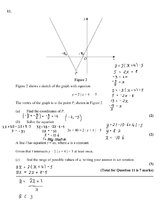You are using an out of date browser. It may not display this or other websites correctly.
You should upgrade or use an alternative browser.
You should upgrade or use an alternative browser.
Functions
- Thread starter Sophie02
- Start date
Steven G
Elite Member
- Joined
- Dec 30, 2014
- Messages
- 14,603
(2x+3)/x is NOT 3.
2x/x is NOT 0, and even if it was 0, you still need to divide the 3 by x!
(2x+3)/x = (2x/x) + (3/x) = 2 + 3/x.
Think about what is required for the line y=ax (a line that crosses the origin) to cross the function in exactly one place. Do not use algebra, but rather think how this can be done. Draw lines and figure out the requirement for the slope.
2x/x is NOT 0, and even if it was 0, you still need to divide the 3 by x!
(2x+3)/x = (2x/x) + (3/x) = 2 + 3/x.
Think about what is required for the line y=ax (a line that crosses the origin) to cross the function in exactly one place. Do not use algebra, but rather think how this can be done. Draw lines and figure out the requirement for the slope.
Last edited:
(2x+3)/x is NOT 3. 2x/x is NOT 0, and even if it was 0, you still need to divide the 3 by x!
(2x+3)/x = (2x/x) + (3/x) = 2 + 3/x.
Think about what is required for the line y=ax (a line that crosses the origin) to cross the function in exactly one place. Do not use algebra, but rather think how this can be done. Draw lines and figure out the requirement for the slope.
Is the answer a>2 and a<-2?
Steven G
Elite Member
- Joined
- Dec 30, 2014
- Messages
- 14,603
Maybe? Can you explain why? Did you miss one other a value?Is the answer a>2 and a<-2?
Maybe? Can you explain why? Did you miss one other a value?
I used desmos to see where the lines would cross. But it is to do with how steep the gradients are. But I don’t think there is another one because it seems to cross both lines otherwise
HallsofIvy
Elite Member
- Joined
- Jan 27, 2012
- Messages
- 7,760
You say your answer to (a) is "defiantly wrong" but you don't want help with that?
You have the graph of y= 2|x+ 4|- 5. The best way to handle an absolute problem is to look at "cases".
1) if x> -4, x+ 4 is positive so |x+ 4|= x+ 4. y= 2|x+ 4|- 5= 2(x+ 4)- 5= 2x+ 8- 5= 2x+ 3.
2) If x< -4, x+ 4 is negative so |x+ 4|= -(x+ 4)= -x- 4. y= 2|x+ 4|- 5= 2(-x- 4)- 5= -2x- 8- 5= -2x- 13.
(a) P is where the two lines intersect, at x=-4. y= 2(-4)+ 3= -5 and y= -2(-4)- 13= 8- 13= -5.
P= (-4, -5).
(b) says "solve the equation". The only equation here is y= 2|x+ 4|- 5 so I would conclude that this asking us to solve for x in terms of y. Again,write in two cases:
y= 2x+ 3 so y- 3= 2x and x= (y- 3)/2. If x> -4 then y> -5.
y=-2x- 13 so y+ 13= -2x and x= -(y+ 13)/2. If x< -4 then y< -5
so x= (y- 3)/2 for y>-5 and x= -(y+ 13)/2 for y< -5.
For (c) we have a line y= ax. The right side of the absolute value function has slope 2. y= ax has slope a and will be parallel to that line for a= 2. Any a< 2 will intersect at a point above the x-axis. The slope of the line from (-4, 5) to (0, 0) is -5/4 so any a> -5/4 will intersect below the x-axis. a must be between -2 and -5/4.
You have the graph of y= 2|x+ 4|- 5. The best way to handle an absolute problem is to look at "cases".
1) if x> -4, x+ 4 is positive so |x+ 4|= x+ 4. y= 2|x+ 4|- 5= 2(x+ 4)- 5= 2x+ 8- 5= 2x+ 3.
2) If x< -4, x+ 4 is negative so |x+ 4|= -(x+ 4)= -x- 4. y= 2|x+ 4|- 5= 2(-x- 4)- 5= -2x- 8- 5= -2x- 13.
(a) P is where the two lines intersect, at x=-4. y= 2(-4)+ 3= -5 and y= -2(-4)- 13= 8- 13= -5.
P= (-4, -5).
(b) says "solve the equation". The only equation here is y= 2|x+ 4|- 5 so I would conclude that this asking us to solve for x in terms of y. Again,write in two cases:
y= 2x+ 3 so y- 3= 2x and x= (y- 3)/2. If x> -4 then y> -5.
y=-2x- 13 so y+ 13= -2x and x= -(y+ 13)/2. If x< -4 then y< -5
so x= (y- 3)/2 for y>-5 and x= -(y+ 13)/2 for y< -5.
For (c) we have a line y= ax. The right side of the absolute value function has slope 2. y= ax has slope a and will be parallel to that line for a= 2. Any a< 2 will intersect at a point above the x-axis. The slope of the line from (-4, 5) to (0, 0) is -5/4 so any a> -5/4 will intersect below the x-axis. a must be between -2 and -5/4.
Steven G
Elite Member
- Joined
- Dec 30, 2014
- Messages
- 14,603
No, a>2 and a<2 is not part of the answer. Find the slope of each line, and then see which lines through the origin will cross just one of the two lines. Then there is one more line.Is the answer a>2 and a<-2?

